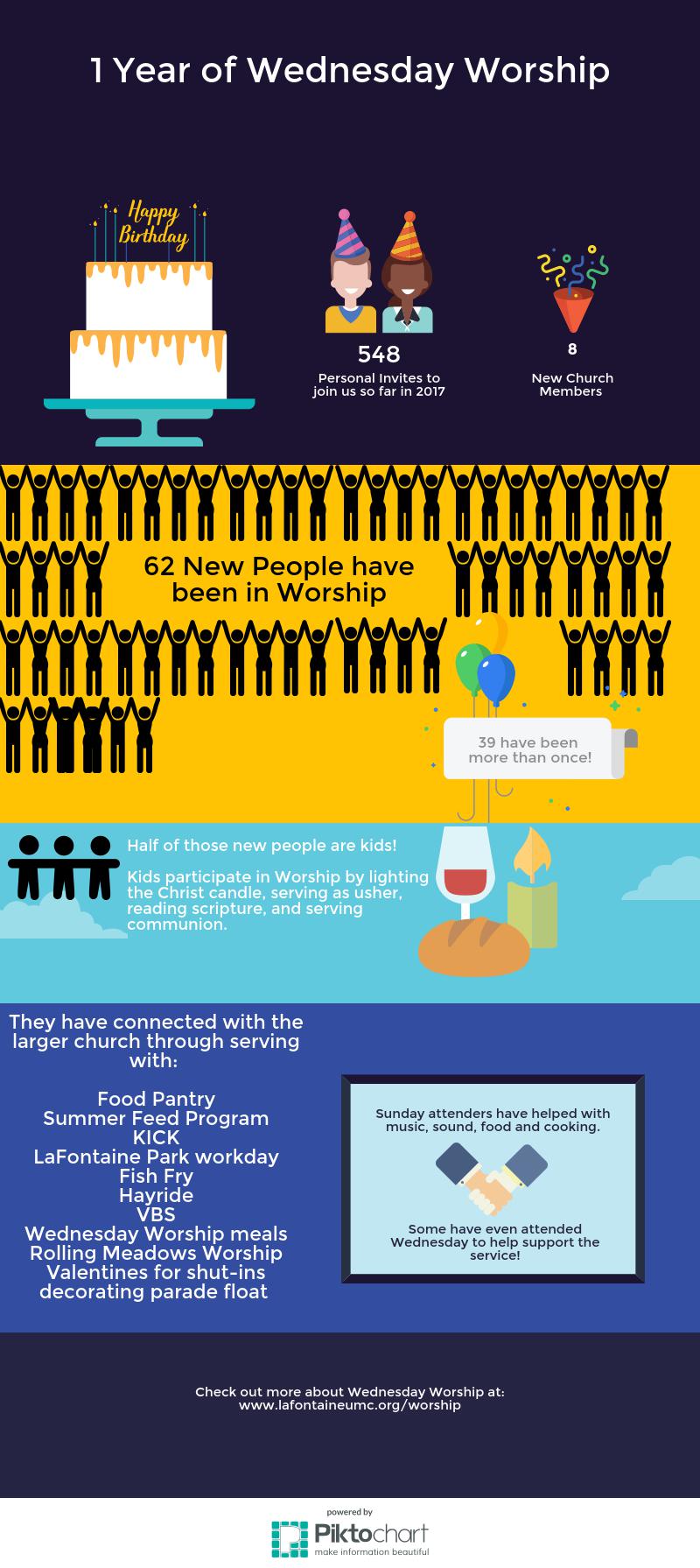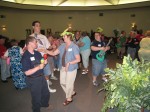 Michael Coyner, Bishop of the United Methodist churches in Indiana, has a dream of churches launching 100 new opportunities for worship this coming year. Why? Because new worship services are more likely to reach new people than existing ones. He envisions these new opportunities as being started both inside church buildings but also in community venues as well. He sees them being started not only by a church’s pastor but by its laity. He envisions them taking on a variety of forms, tailored to their target populations.
Michael Coyner, Bishop of the United Methodist churches in Indiana, has a dream of churches launching 100 new opportunities for worship this coming year. Why? Because new worship services are more likely to reach new people than existing ones. He envisions these new opportunities as being started both inside church buildings but also in community venues as well. He sees them being started not only by a church’s pastor but by its laity. He envisions them taking on a variety of forms, tailored to their target populations.
Too often I have witnessed eager, well intentioned churches doing just that, launching a new worship service, only to see them fail. First, if we aren’t willing to risk failure and to learn from the experience, then we shouldn’t attempt new ministry efforts. Second, if you’re going to launch a new service, wouldn’t you want to do all you can for it to succeed? To that end, wouldn’t it be great if you could learn from other churches’ attempts, both their successes and failures? Well, here you go. What follows will provide you and your church such a guide. Follow its advice, and you’re likely to see your new worship service succeed–transforming lives, bringing new people into Christ’s presence.
— Ed Fenstermacher, Associate Director of Church Development
Launching a New Worship Service
In order to effectively launch a new service, I suggest you consider these following steps:
A. PRAYER. I can’t overstate how important it is to have the church intentionally praying for this effort. If you don’t already have groups and/or individuals praying specifically for this effort, I encourage you to do that right away.
B. IDENTIFY TARGET GROUP. Before you make any decisions (e.g. when and where the service is to be held, its style and format, even its name), it is important to know who you sense God is wanting you to especially reach. Of course, the service will be open to anyone; however, the reality is that it will be especially inviting and inspiring for a certain type of person. The more you clearly you can describe that person, the easier it will be to design a service for them, and as a result, you’ll be more likely to reach them.
- A church will typically attract is people like themselves. You may want to describe the type of people First UMC naturally attracts. If you sense God is calling you to reach a different group of people, you will probably have to take extra care in designing the service (when, where, its style, how the invitations are shared, etc.).
- The target group could be determined by matching those God already is bringing to your church (e.g. Sunday morning newcomers, those you reach through the week, during VBS, etc.).
- The target group also could be identified using the community’s demographics. Keep in mind that you do not need to target the largest demographic lifestyle groups in your community.
- Whichever way you determine your target group, I encourage you to write down a description of that group (e.g. where they’re at on their spiritual journey, their mindset, their unique needs, their music preferences, etc.).
C. BUILD YOUR LAUNCH TEAM. The launch team will help answer the questions regarding when and where the service will meet, determine when it will be launched, the design of the service, how to get invitations out, setting a budget, dealing with logistical issues such as child care, parking, set-up, technology needs, etc. Set a goal to have at least half your launch team reflect your target group.
D. DEFINE WHAT A “WIN” LOOKS LIKE. In order for everyone to have a clear understanding of what the church hopes to establish, the launch team needs to describe how the church will know if its new service is successful. What are the metrics that will determine whether or not the service should be continued or not? This needs to be clearly defined before the service is ever launched, that way the expectation is clear to everyone and it will be easier to determine the service’s viability.
E. DETERMINE YOUR LAUNCH STRATEGY. There are two basic approaches you can use to launch the service. One is to focus on developing relationships with your target group (e.g. one-to-one conversations, listening sessions, small groups, etc.) before you start the service. This can take as much as six months to two years to do. The second is to rely primarily on word-of-mouth and marketing to launch the service and then to develop relationships once they attend.
The advantage of the first approach is that it provides a more solid congregation when you launch. The downside is that it takes more time (six month to two years). Your launch team needs to decide which approach it will take.
F. ESTABLISH TASK FORCE TEAMS. The next step is for the launch team to identify all the tasks that will need to be done. They might fall into the following areas: a) prayer support, b) worship design, c) logistics (parking, technology, set-up), d) child care, e) publicity/invitations, f) hospitality/discipleship of newcomers, and h) finances. Identify who will head up each of these areas and have them establish an implementation timeline. (See below for an example of a timeline for an effort to launch an off-site worship service.) To track your progress in recruitment, create a leadership matrix organized by task area. Write in each name as individuals are recruited. Your goal should be to fill 90% of your leader/helper slots for each task area by the public launch of the new service.
G. SUNDAY MORNING SCHEDULE. If the launch team (or church’s worship team) determines that the new service should be held at the church on a Sunday morning, make sure adequate parking is available. If you need to adjust the present worship times to fit the new service into the schedule, it is advised not to move the present times more than 30 minutes either direction. Make sure those having to accommodate the new schedule clearly understand why the change is important and provide them with ongoing updates as to the positive results due to the change (e.g. short videos of the new service being shown at the original service/s).
H. CRITICAL MASS. As I said, it is extremely important to have your worship meeting space always at 50% or more of the room’s capacity. Otherwise, it will feel as though there is a lack of energy and the service won’t be as attractive to newcomers. This means that you won’t want to launch the service until you know you’ll be able to consistently fill half (or more) of the seats.
I. LAUNCHING YOUR SERVICE. It is recommended that you do a soft launch of your service to work out the bugs before doing your public “official” launch. During this time, which could be as many as three months, you can begin your marketing effort for your public launch. Word of mouth is by far the best way to reach people. Encourage core attenders to the soft launch services to identify three people they know who would like the new service, have them pray for them, then set a date each month that they are encouraged to intentionally invite them to attend with them. Have attenders to the soft launch provide feedback on the various components of the service and make ongoing adjustments to improve the experience.
J. FOLLOWING YOUR LAUNCH. Make sure to implement your system to welcome and involve new attenders. Invite the newcomers to fill the remaining 10% of the leader/helper slots in your matrix. Continue to engage newcomers by inviting them into missional and discipleship opportunities as well. At some predetermined point/s (e.g. 6 months, 12 months), evaluate the new service, referring back to your description of what a “win” would look like (D above). Make adjustments as needed.
Sample Launch Timeline
Month 1
1. Clarify your vision for the new service. Who is God calling you to reach?
2. Establish a pray team (at least 3 persons) to pray.
Month 2
1. Put together a design team (5-12 people), at least half of whom represent the target group.
2. Identify all the potential prospects that are in the target group (e.g. preschool families, VBS participants, scout families, etc.). Invite them to a focus group.
Month 3
1. Hold focus groups with your prospects testing your vision for the new service. Help them determine when and where the service should be held and its style, whether it should be designed to include children and food. Ask the focus group for others who might be interested in the service and hold a focus group with them. Add all of them to your prospect list.
2. Refine your vision accordingly. Define what a “win” will look like.
Month 4
1. Further refine your worship design and establish needed task teams using a leadership matrix. Begin recruiting the needed leaders from your prospect list.
2. Begin internal communication in the church about the service and the leadership and volunteer needs.
Month 5
1. Finalize the budget and develop the marketing/outreach plan.
2. Continue to fill the leadership/volunteer matrix.
Month 6
1. Hold a pre-launch worship service and evaluate.
2. Begin to implement the marketing/outreach plan. Get children’s ministry and hospitality plans finalized. Develop a newcomer follow-up/assimilation plan that includes getting them involved in discipling opportunities.
Month 7
1. Hold another pre-launch worship service and evaluate. Include the hospitality and children’s ministry components.
2. Lead the church in a special prayer effort for the new service. Collect prospects’ contact information and share with the marketing/outreach team.
Month 8
1. Hold a final pre-launch worship service with all components in place and evaluate.
2. Continue to implement the marketing/outreach plan and finalize the follow-up/ assimilation process for newcomers.
3. The leadership matrix should be 90% filled.
Month 9
1. Publically launch the worship service. Evaluate and celebrate.
2. Implement the follow-up/implementation process for newcomers.
Month 10
1. Begin inviting newcomers to fill vacancies on the leadership matrix and to serve.
2. Continue evaluating all components of the service, continue the marketing/ outreach.
3. Begin inviting participants into discipleship opportunities.
At a predetermined date (e.g. 6 months or 12 months after launch)
Evaluate the service against the definition set in month 3 of a “win.” Decide whether to continue the service.











